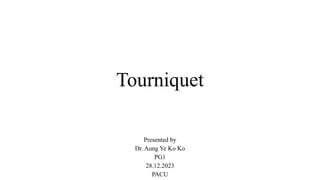
Tourniquet vs reperfusion in Orthopedic surgery especially replantation.pptx
- 1. Tourniquet Presented by Dr. Aung Ye Ko Ko PG1 28.12.2023 PACU
- 2. Contents • Introduction • Indications • Contraindications • Types of Tourniquet • Changes On Cuff Deflation • Complications
- 3. Introduction • Use of arterial tourniquet greatly facilitates bloodless field during upper and lower limb orthopedic surgeries.
- 4. Indications To provide bloodless field for surgery: • For better identification of structures • Reduced operative time • Reduced surgical complications • Reduced need for blood transfusion
- 5. Contraindications • Peripheral vascular disease (Raynaud’s disease) • Deep vein thrombosis • AV fistula/arterial calcific disease • Peripheral neuropathy/CNS disorder • Severely injured/traumatized limb • Severe infection in limb • Bone abscess • Sickle cell disease: Use is controversial as sickling is • promoted by hypoxia/acidosis
- 6. Types of Tourniquet • Non Pneumatic Tourniquet • Pneumatic Tourniquet
- 7. Non Pneumatic Tourniquet • Infusion tubes • Surgical gloves • Esmarch bandage • Martin sheet rubber • Others/ improvised
- 8. Pneumatic Tourniquet • Are based on the principles of blood pressure cuffs but they are stronger
- 9. Changes On Cuff Deflation • Mild systemic metabolic acidosis (preinflation pH of 7.4 reduces to 6.9, 2 hours after deflation) • Increased PaCO2 (1–8 mm Hg) • Raised lactate levels • Increased K+ levels (5–10% increase) • Transient rise in ETCO2 levels • Transient fall in systolic BP: 14–19 mm Hg • Transient fall in heart rate: 6–12 bpm • Transient fall in temperature by 0.7°C • All these changes are due to release of toxic metabolites from the occluded limb, such as carbon dioxide, lactic acid, and potassium
- 10. Complications 1. Tourniquet Pain 2. Hemodynamic Changes 3. Tourniquet Hypertension 4. Pulmonary Embolism 5. Metabolic Changes 6. Postoperative Edema 7. Delayed Return of Blood Flow After Tourniquet Release 8. Trauma 9. Nerve injury
- 11. 1. Tourniquet Pain • Occurs in 66% cases 30–60 minutes after giving RA • Clinical features: Dull, deep, burning, and poorly localized pain Hypertension, tachycardia, diaphoresis
- 12. 2. Haemodynamic Changes • Exsanguination: Results in movement of blood from peripheral to central circulation • Causes increased SVR and preload to heart • 10–15% increase in heart rate and HTN on cuff inflation • Cardiac arrest, LV failure • Deflation of cuff: Causes reduced SVR • This causes acute blood loss which may continue for 24 hours • Also causes release of metabolites: May require cardiac support with inotropes
- 13. 3. Tourniquet Hypertension • Occurs due to tourniquet pain • Begins three-fourths to 1 hour after cuff inflation 4. Pulmonary Embolism • Pulmonary embolism possible following exsanguinations/ cuff deflation in TKR • Silent DVT may be the cause and high index of suspicion is required
- 14. 5. Metabolic Changes • Increased PaCO2 (1–8 mm Hg), reduced pH, increased lactate and K+ levels • Only increase in PaCO2, in head injury patients may cause increased CBF and raised ICP • Body temperature increases in pediatric patients during tourniquet inflation 6. Postoperative Edema • Due to return of exsanguinated blood and postischemic reactive hyperemia • Can be due to arterial flow with no venous return during cuff inflation • Post-tourniquet syndrome: Pale and swollen limb for 1–6 weeks postoperatively
- 15. 7. Delayed Return of Blood Flow After Tourniquet Release • Causes are: Arterial injury Compartment syndrome Reperfusion injury
- 16. 8. Trauma • Skin trauma: Due to improper placement of padding under cuff Causes bruising, abrasions, and blistering • Arterial trauma: Causes arterial spasm, arterial thrombus • Venous trauma: Venous thrombus due to stagnant blood • Muscle rhabdomyolysis: If inflation time more than 2 hours 9. Nerve injury: • Called tourniquet palsy • Paroneal and tibial nerve palsy common following TKA with tourniquet inflation ≥ 2 hours